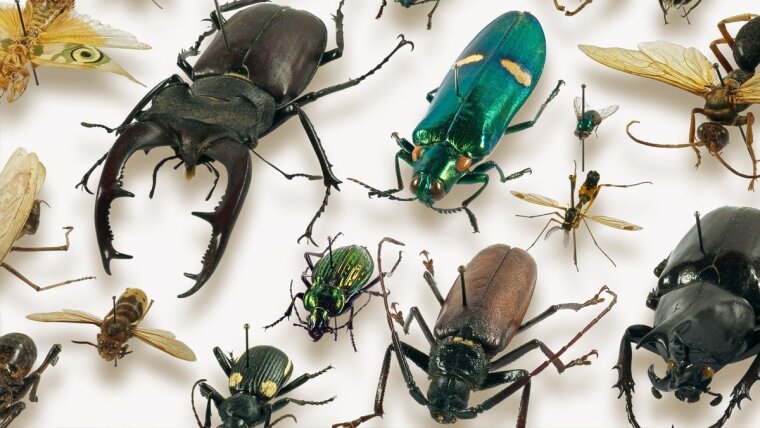
»Als Gregor Samsa eines Morgens aus unruhigen Träumen erwachte, fand er sich in seinem Bett zu einem ungeheuren Ungeziefer verwandelt. Er lag auf seinem panzerartig harten Rücken und sah, wenn er den Kopf ein wenig hob, seinen gewölbten, braunen, von bogenförmigen Versteifungen geteilten Bauch, auf dessen Höhe sich die Bettdecke, zum gänzlichen Niedergleiten bereit, kaum noch erhalten konnte. Seine vielen, im Vergleich zu seinem sonstigen Umfang kläglich dünnen Beine flimmerten ihm hilflos vor den Augen.« Franz Kafka: Die Verwandlung. Leipzig, 1915, S. 1177
Entomology at the Institute of Zoology and Evolutionary Research deals with different aspects in two research groups. The group »Phylogeny and Evolution of Insects« studies evolutionary transformations on the phenotypic level in different groups of insects, with the background of phylogenetic hypotheses. The group »Biodiversity of moths and butterflies« focuses on macroecology, biogeography, phylogeny and systematics of moths.
Phylogeny and Evolution of Insects
The group was founded in 2004 with the appointment of Rolf Georg Beutel as professor of Systematic Zoology and Entomology (Spezielle Zoologie und Entomologie). With the retirement of Prof. Dr. Rolf G. Beutel in 2020, PD. Dr. Hans Pohl took over the leadership of the group.
The development and optimized application of innovative techniques in insect anatomy plays an important role in our research. More specific topics are effects of miniaturisation, and adhesive devices in the context of evolutionary interactions between insects and plants. We are also members of 1KITE, an international project to reconstruct the phylogeny of Hexapoda using transcriptomes. Intensive investigations are focused on the morphology and evolution of various insect orders, such as for instance Strepsiptera, Coleoptera and Neuropterida. We also investigate impression fossils and extinct insects preserved in amber.
Current research projects
- Phylogeny and evolution of twisted-winged parasites (Strepsiptera)
- Phylogeny and evolution of Pselaphinae and other extant and extinct groups of Coleoptera
- Evolution of cephalic and mesosomal structures of extant and extinct groups of ants (Evangelisches Studienwerk Villigst, Alexander von Humboldt Foundation)
- Reproductive and mating strategies of Strepsiptera (DFG, German Research Foundation)
- Physical interactions of adhesive devices of Strepsiptera with different surfaces
- Taxonomy of Strepsiptera
- Development of a workflow for modern integrative species descriptions of insects (DBU, German Federal Environmental Foundation)
Biodiversity of moths and butterflies
The group of Dr. Gunnar BrehmExternal link works on biodiversity, ecology, phylogeny and systematics of moths and butterflies. Model groups are the species-rich moth clades of Geometridae (looper moths) and Arctiinae (tiger moths and woolly bears) and also Sphingidae (hawkmoths), saturniid moths and moth-like butterflies. Field work is carried out both in Europe and South America, where many undescribed species occur. The clear focus is on collection-based research, i.e. our specimens are prepared for long-term storage in the Phyletisches Museum. The investigation of traits in insects is increasingly important, and this involves body size, proboscis length, (UV) color patterns and more.
Check out more about the methods we are using.
A full list of publications here.External link

